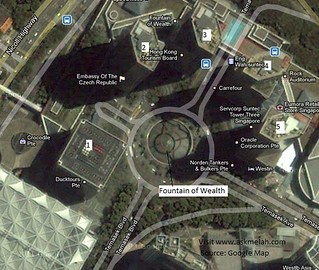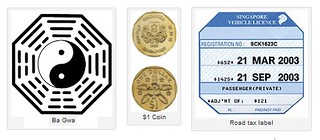Collection of Fengshui Stories in Singapore
Disclaimer: this is meant for knowledge sharing and some details are based on local folklore or hearsay, so take it with a pinch of salt. It is not meant as a fengshui guide.
Feng Shui Buildings
Singapore Flyer
Suntec (Source: Google Map)Each of the 28 air-conditioned capsules is capable of holding 28 passengers, and a complete rotation of the wheel takes about 30 minutes. Initially rotating in a counter-clockwise direction when viewed from Marina Centre, its direction was changed on 4 August 2008 under the advice of Feng shui masters (Source).
The five towers seem to represent five fingers and the fountain of wealth site at the centre of these five skyscrapers seem to symbolise the pot of wealth. It symbolise the five fingers of a left palm with a golden ring and water (wealth in Cantonese) flowing into the ring. It is also said that, if you walk around the central base of the Fountain of Wealth three times while touching the water at all times, you would gain some good luck of your own.
Marina Bay Sands
Its main fengshui element is water. The waterfront placement is auspicious as water represents wealth in fengshui. MBS is built on reclaimed land and this new land is good as it comes without any ‘baggage’. the integrated resort’s fengshui consultant was the late Master Ching Swan Lek. His disciple, master Louisa Ong-Lee, has taken over the consultations.
According to Master Ong-Lee, the three towers represent three mountains or warriors guarding the gateway to Singapore. The SkyPark is like a scholar’s hat, symbolising new skills being acquired, while the three domes in front symbolise three coins which stand for prosperity. The lotus shaped Art Science Museum is designed like an open palm, a gesture of giving and welcoming.
Read an excellent blog on the controversy and varying opinions surrounding the MBS fengshui here.
Merlion
In Sep 2002, the sculpture was moved from the mouth of the Singapore River to its present location. Official reason given was Esplanade Bridge had blocked the view of the Merlion from the Marina Bay front but the rumour had it that the FengShui was bad for Singapore since the bridge was constructed and the republic’s economy was dealt with double blow of 1997 Asian Crisis and 2003 SARS outbreak. Though the timings do not seems exactly right, miraculously the economy began to recover shortly after the Merlion was relocated to its present location and the republic fortune has been prosperous ever since.
The Gateway
 This is a classic example of a bad fengshui building despite the fact The Gateway was designed by world renowned architect IM Pei. The two buildings look like two sharp knives and the vast land in front of it were left vacant for years (rumour has it that) because no local developers will want to build properties there despite its prized prime location. The vacant site now belongs to the Malaysian Government since 2011 as part of the deal for the closure of the Tanjong Pagar Railway station and the land parcels along the railway track. Let’s see if the Malaysian Government is able to defy the fengshui curse to turn the Fengshui around.
This is a classic example of a bad fengshui building despite the fact The Gateway was designed by world renowned architect IM Pei. The two buildings look like two sharp knives and the vast land in front of it were left vacant for years (rumour has it that) because no local developers will want to build properties there despite its prized prime location. The vacant site now belongs to the Malaysian Government since 2011 as part of the deal for the closure of the Tanjong Pagar Railway station and the land parcels along the railway track. Let’s see if the Malaysian Government is able to defy the fengshui curse to turn the Fengshui around.
Wheelock Place
Another structure of a bad feng shui in Singapore is Wheelock Place. Despite sitting on a super prime land next to the Orchard MRT station, famous bookstore Borders has gone out of business there.Its first tenant Lane Crawford Department Store had sized down their operations from five floors to two floor and ceased business altogether before Borders took over.
The building itself was completed in 1994 but closed down during 1990s due to Asian Financial Crisis.
Old Hill Street Police Station (MICA Building)

There are two”hidden” Bagua specially designed to suppress the bad Feng Shui of this controversial building. It is not easy to spot it, I tried to find them but failed. Try asking the MICA Perm Sect Chan Yeng Kit, someone once told me he might know something about it.
Other Singapore Feng Shui Myths
Ba Gua and the fifty dollar bill (Adapted from Source)
Singapore’s good fortune has been attributed to the persistent practice of Feng Shui by Singapore’s Prime Minister, Lee Kuan Yew. When building the MRT system in the eighties, the construction caused a decline in the economy (it was said that the proposed constellation of MRTs tunnels and the huge amount of metal being driven deep into the Singapore bed rock would sever Singapore’s Dragon Vein which is very bad for the nation’s feng shui). During a Feng Shui consultation (reportedly the highly respectable Venerable Hong-Chuan), Mr. Lee was told that Singapore’s fortune could be improved by hanging up a Ba Gua, the eight-sided Feng Shui symbol. Since the government was not sold on the placement of such a Chinese symbol, Mr. Lee instead introduced a Ba Gua-shaped one dollar coin. When the economy still did not recover, he created road tax disks in the shape of the Ba Gua and the economy immediately improved. (And consequently, every car in Singapore began hanging this symbol in their windshield.)
 Years later, Mr. Lee was told that a dragon placed looking over the mouth of Singapore River and the Merlion, Singapore’s symbol, would ensure Singapore’s good fortune. So on the top left-hand corner of the country’s fifty dollar bill, Mr. Lee placed a scene of the Singapore River, harbour, and Merlion. In this way the dragon would be forever symbolically poised above the Merlion, thereby safeguarding its prosperity forever.
Years later, Mr. Lee was told that a dragon placed looking over the mouth of Singapore River and the Merlion, Singapore’s symbol, would ensure Singapore’s good fortune. So on the top left-hand corner of the country’s fifty dollar bill, Mr. Lee placed a scene of the Singapore River, harbour, and Merlion. In this way the dragon would be forever symbolically poised above the Merlion, thereby safeguarding its prosperity forever.
$1 coin and the 1997 Financial Crisis (adapted from source)
Remember the Asian Financial Crisis that happened back in 1997 which hit Singapore pretty badly?
It was said that MM Lee consulted a fengshui master about what he could do to improve the situation caused by the Asian Financial Crisis, and the fengshui master swiftly gave a solution, that is the change the way the back of the coin is designed.“The Singaporeans are already so upset over the financial crisis, yet the $1 coin still has a sad looking face. How can?!! Change change change!” he said. So it goes from a sad face to a smeily face and the economy swiftly recover in the next two years.
The Green Singapore (Crab)
Ever wonder why Singapore is known as a Garden City? After all, maintaining a Garden City is very expensive.
If you were to look at Singapore skyline from the aerial view, Singapore resembles a crab, with its mouth the Singapore river and its back facing Malaysia. A cooked crab which means dead crab is red, the colour of barren ground. But a live crab is a dark shade of green. So,by planting trees, you make Singapore look green and not red, and therefore alive.

Related links:
- Feng Shui, Architecture & the Lion City
- Feng Shui in Singapore
- Feng Shui Tour of Singapore
- The FengShui of 2015 Election
- 鬼门关闭前其余3天皆凶命理师:911是难得吉日
- Fengshui master claims S’poreans are ‘digging our own graves’ — Her predictions made me wonder whether our rapid development is going to cause the death of us all eventually.”….Because of the disruption of Singapore’s geographical ‘Dragon Venture’.
- Fengshui master recommendations/discussions



Recent Comments